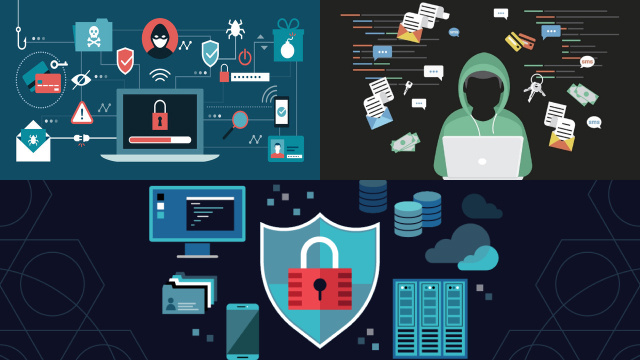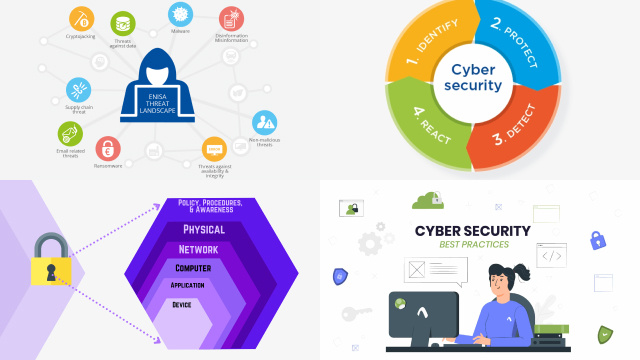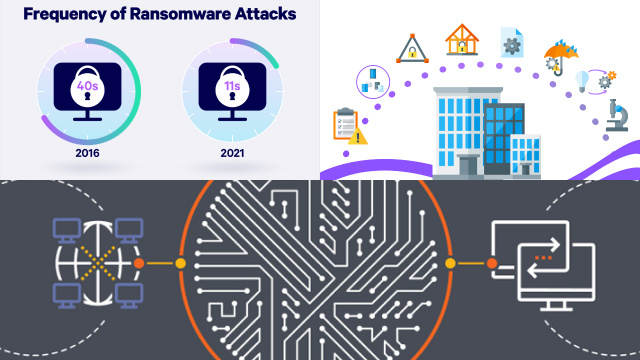Understanding Cyber Attacks: A Comprehensive Guide to Protection
In today’s interconnected world, understanding cyber attacks is crucial for safeguarding your digital life. This comprehensive guide provides you with essential knowledge and insights to protect yourself against these ever-evolving threats.
Cyber attacks come in various forms, such as malware, phishing, ransomware, and more. Understanding their mechanisms is the first step towards effective protection. By familiarizing yourself with common attack vectors and techniques, you can better identify and mitigate potential risks.
To fortify your defenses, implementing robust cybersecurity measures is essential. This includes regularly updating your software, using strong and unique passwords, enabling two-factor authentication, and backing up your data securely. Additionally, employing reliable security software and firewalls can act as strong deterrents against attacks.
Education and awareness play a pivotal role in cyber attack prevention. By staying informed about the latest threats and trends, you can adapt your defense strategies accordingly. Regularly educating yourself and your employees on best practices, such as avoiding suspicious links and practicing safe browsing habits, will strengthen your overall security posture.
Remember, cybersecurity is an ongoing effort. By continuously updating your knowledge, leveraging advanced security tools, and fostering a culture of cyber vigilance, you can stay one step ahead and protect yourself against the ever-present threat of cyber attacks.
Building Your Cyber Defense: Essential Steps to Safeguard Against Attacks
Building a strong cyber defense is crucial in today’s digital landscape where the threat of cyber attacks looms large. By taking essential steps to safeguard against attacks, you can protect your sensitive information and preserve your online security.
First and foremost, maintaining strong and unique passwords is paramount. Ensure that your passwords are complex, incorporating a combination of uppercase and lowercase letters, numbers, and special characters. Regularly update your passwords and avoid using the same password across multiple accounts.
Implementing robust security measures such as antivirus software, firewalls, and intrusion detection systems is vital. Regularly update these tools to ensure they have the latest security patches and definitions, offering maximum protection against emerging threats.
Backing up your data regularly is another essential step in building your cyber defense. In the event of a successful attack, having secure backups ensures that you can quickly recover your critical files and minimize the impact of potential data loss.
Furthermore, fostering a culture of cybersecurity awareness is key. Educate yourself and your employees on best practices such as identifying phishing attempts, exercising caution when downloading files or clicking on links, and keeping an eye out for suspicious activities.
By proactively building your cyber defense through these essential steps, you can fortify your digital infrastructure and significantly reduce the risk of falling victim to cyber attacks. Stay vigilant, stay informed, and stay secure.
The Threat Landscape: Recognizing and Defending Against Cyber Attacks
In the ever-evolving digital world, understanding the threat landscape is crucial for effectively recognizing and defending against cyber attacks. By staying informed and vigilant, you can bolster your defenses and mitigate potential risks.
Recognizing the different types of cyber attacks is the first step in combating them. From malware and ransomware to social engineering and phishing scams, each attack vector requires specific attention and countermeasures. Educate yourself on the latest attack techniques and tactics employed by cybercriminals to better identify and respond to potential threats.
Implementing a multi-layered defense strategy is essential. This includes utilizing robust antivirus software, firewalls, and intrusion detection systems to monitor and protect your network and devices. Regularly updating your software and promptly applying security patches ensures you have the latest defenses against known vulnerabilities.
Furthermore, user awareness and education play a pivotal role in defending against cyber attacks. Train yourself and your employees on safe browsing habits, recognizing suspicious emails or websites, and practicing good password hygiene. Encourage a culture of skepticism and empower individuals to report any potential security incidents promptly.
By recognizing the evolving threat landscape and implementing proactive defense measures, you can strengthen your resilience against cyber attacks. Stay informed, stay vigilant, and stay one step ahead of those seeking to compromise your digital security.
Cybersecurity 101: Key Measures to Protect Against Attacks
In the digital age, understanding the fundamentals of cybersecurity is essential for safeguarding your sensitive information and protecting against cyber attacks. Here are some key measures to consider in your cybersecurity arsenal.
Firstly, keeping your software up to date is crucial. Regularly installing security patches and updates ensures that known vulnerabilities are patched, reducing the risk of exploitation by cybercriminals.
Secondly, implementing strong and unique passwords is a simple yet effective measure. Use a combination of uppercase and lowercase letters, numbers, and special characters to create complex passwords. Avoid reusing passwords across different accounts to prevent unauthorized access.
Thirdly, enable two-factor authentication (2FA) whenever possible. This adds an extra layer of security by requiring an additional verification step, such as a unique code sent to your mobile device, when logging into an account.
Another important measure is to be cautious of suspicious emails, links, and attachments. Exercise skepticism and verify the legitimacy of requests or offers before taking any action.
Lastly, regular data backups are crucial for mitigating the impact of a potential cyber attack. Ensure that your important files and data are regularly backed up to an external or cloud storage location.
By implementing these key measures, you establish a strong foundation for cybersecurity. Remember, cybersecurity is an ongoing effort, and staying informed about emerging threats and best practices is essential in protecting yourself against evolving cyber attacks.
Staying One Step Ahead: Proactive Strategies for Cyber Attack Protection
In the ever-evolving landscape of cyber threats, staying one step ahead is crucial for effective cyber attack protection. Adopting proactive strategies can significantly enhance your defenses and minimize the risk of falling victim to malicious actors.
Regularly updating your software and operating systems is a fundamental proactive measure. Security patches and updates often address known vulnerabilities, ensuring that your systems are fortified against emerging threats.
Implementing robust security measures such as firewalls, antivirus software, and intrusion detection systems is vital. These proactive defenses create barriers and monitor network activity, detecting and preventing unauthorized access and malicious activities.
Employing strong access controls and user management practices is another proactive strategy. Implementing least privilege principles and regularly reviewing user permissions help minimize the potential impact of compromised accounts.
Regular security awareness training for employees is crucial in promoting a culture of cyber vigilance. Educate your staff about phishing attacks, social engineering techniques, and safe browsing practices. By fostering a security-conscious workforce, you create an additional layer of defense against cyber threats.
Lastly, staying informed about the latest trends and emerging threats is key to proactive cyber attack protection. Stay updated with security news, subscribe to industry alerts, and leverage threat intelligence resources to anticipate and proactively mitigate potential risks.
Securing Your Digital Assets: Best Practices to Thwart Cyber Attacks
Securing your digital assets is of utmost importance in today’s interconnected world, where cyber attacks pose a constant threat. By implementing best practices, you can effectively thwart cyber attacks and protect your valuable digital assets.
First and foremost, regularly updating your software and operating systems is essential. Software updates often include security patches that address known vulnerabilities, making it harder for attackers to exploit them.
Implementing strong and unique passwords is a simple yet crucial measure. Use a combination of uppercase and lowercase letters, numbers, and special characters. Additionally, consider using a password manager to securely store and generate complex passwords for your various accounts.
Enabling multi-factor authentication (MFA) provides an extra layer of security. By requiring additional verification, such as a unique code or biometric authentication, MFA adds an additional barrier against unauthorized access.
Backing up your data regularly is vital. This ensures that in the event of a successful attack or data loss, you can restore your files and resume normal operations without significant disruption.
Educating yourself and your employees about common cyber threats and best practices is essential. Train your team to identify phishing attempts, exercise caution when downloading files or clicking on links, and be wary of social engineering techniques.
Emerging Threats: Adapting Your Defense to Evolving Cyber Attacks
As technology advances, so do the tactics and techniques employed by cyber attackers. To effectively protect your digital assets, it is essential to adapt your defense strategies to the ever-evolving landscape of emerging threats.
Staying informed about the latest emerging threats is the first step. Regularly monitor industry news, subscribe to threat intelligence sources, and participate in cybersecurity communities to stay up-to-date with the latest trends and attack vectors.
Implementing a proactive defense strategy is crucial. Regularly update your security measures, including antivirus software, firewalls, and intrusion detection systems, to ensure they can detect and mitigate new threats effectively.
Conduct regular risk assessments to identify potential vulnerabilities and prioritize remediation efforts. By understanding your weaknesses, you can take proactive steps to strengthen your defenses and minimize the likelihood of successful attacks.
Investing in employee education and awareness is vital. Train your staff on emerging threats, such as ransomware, social engineering, and zero-day exploits. Encourage a culture of vigilance and provide them with the knowledge to identify and report potential incidents promptly.
Collaboration with industry peers and security experts can also provide valuable insights into emerging threats and effective defense strategies. Participate in forums, conferences, and information-sharing initiatives to leverage collective knowledge and stay ahead of the curve.
By adapting your defense to the evolving cyber attacks, you can effectively protect your digital assets. Stay proactive, stay informed, and continuously evolve your defense strategies to ensure you are prepared to counter emerging threats effectively.




